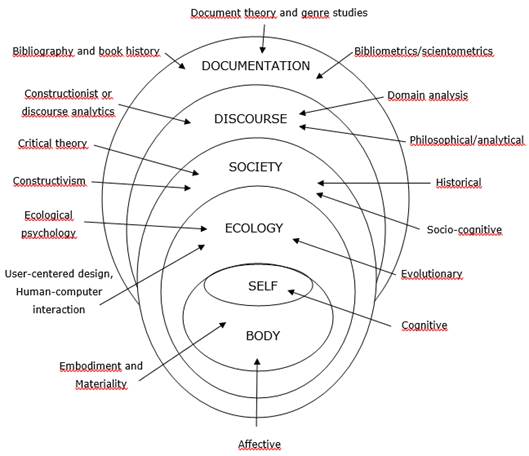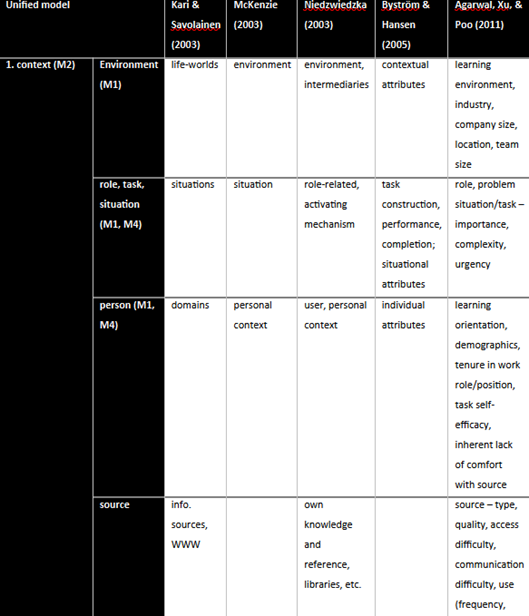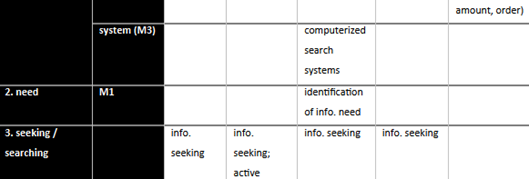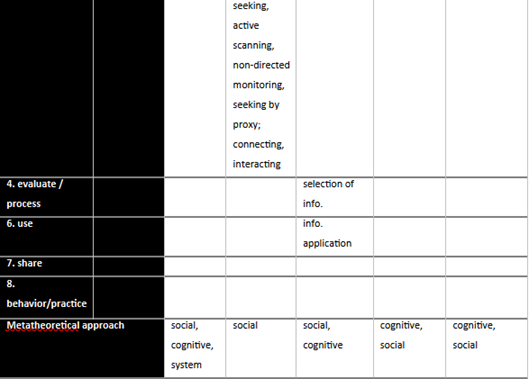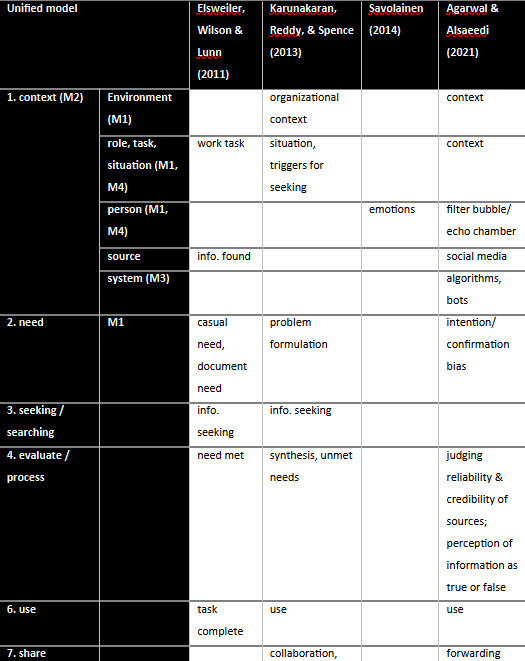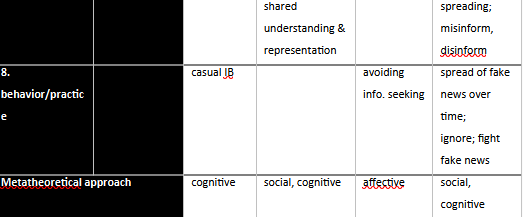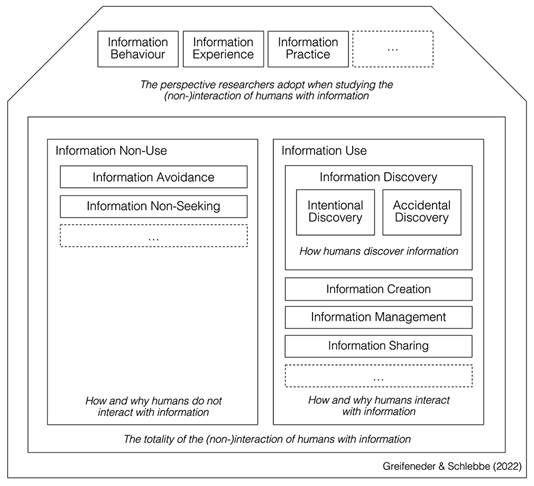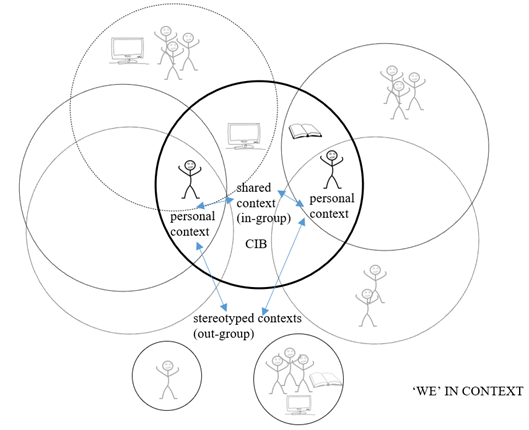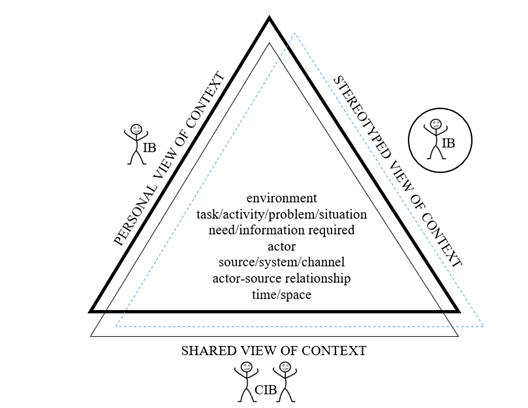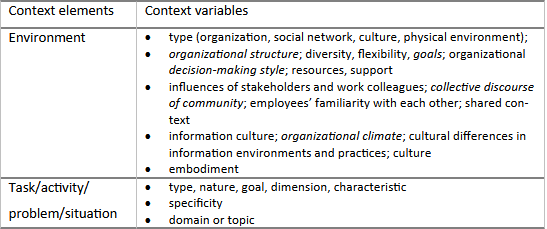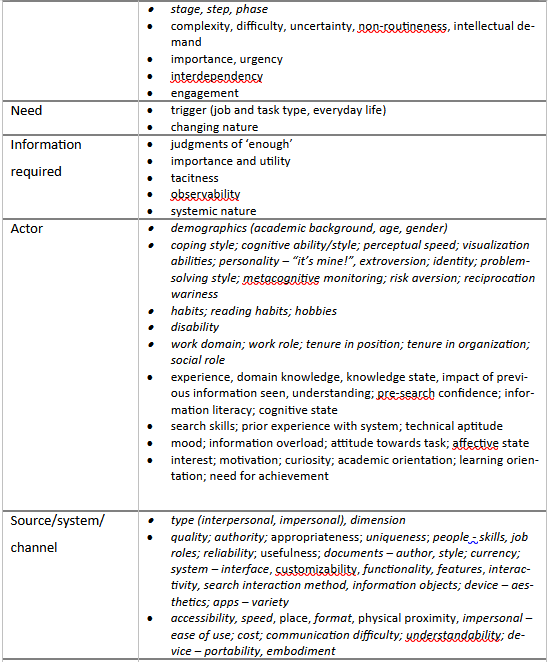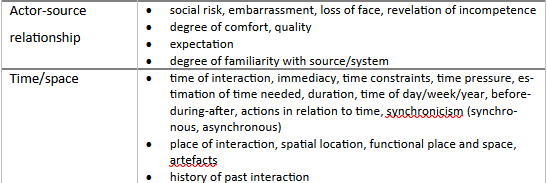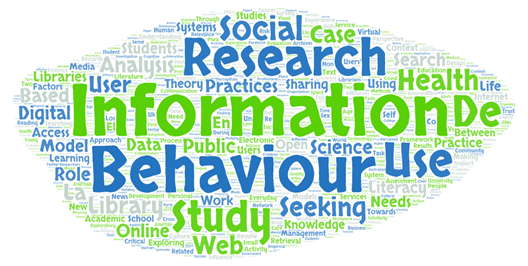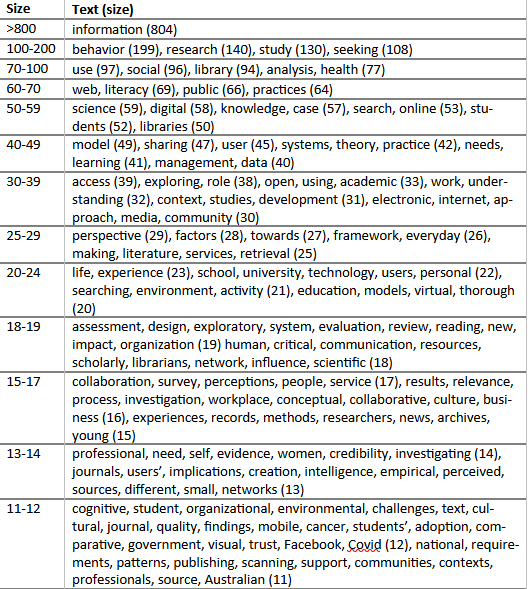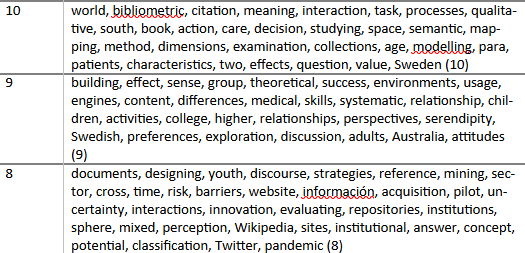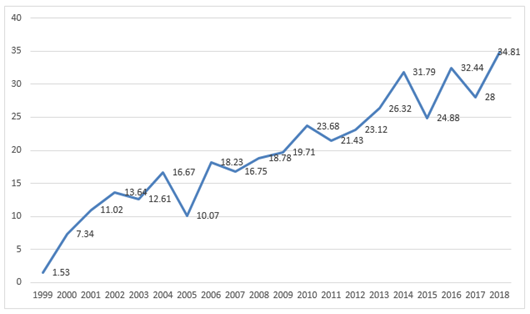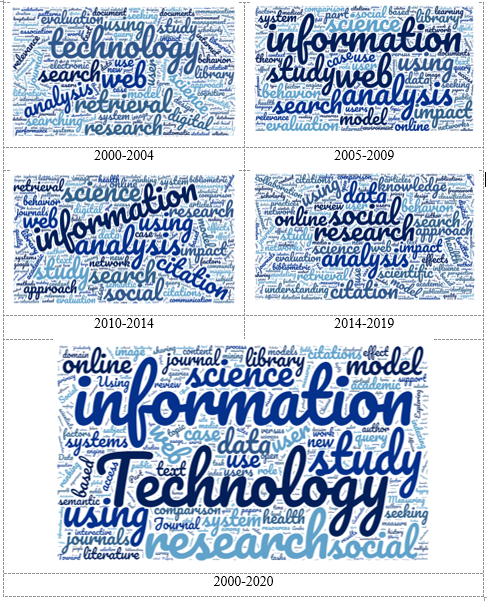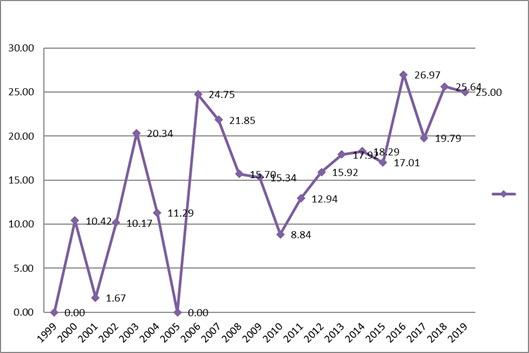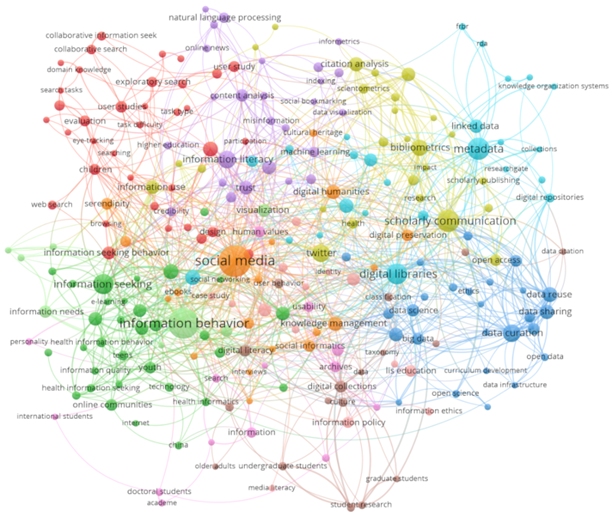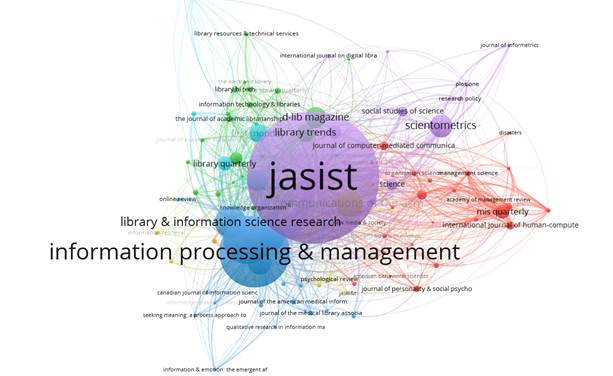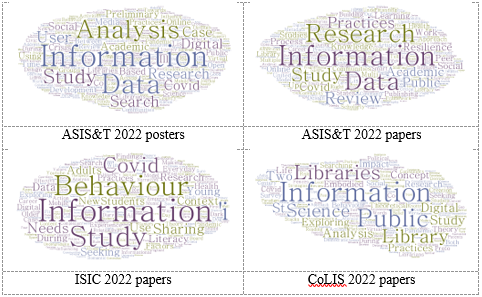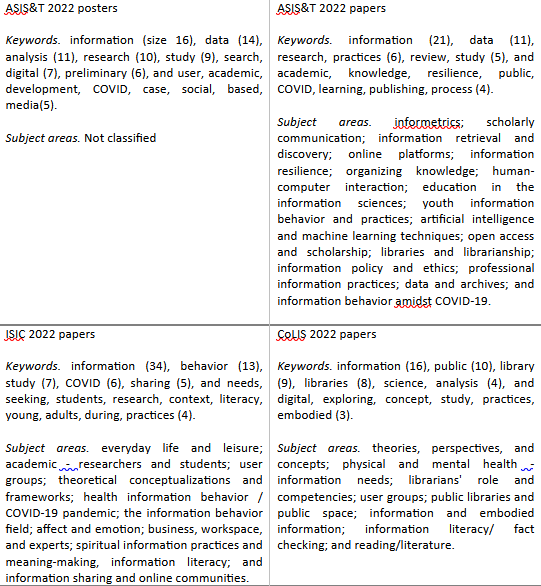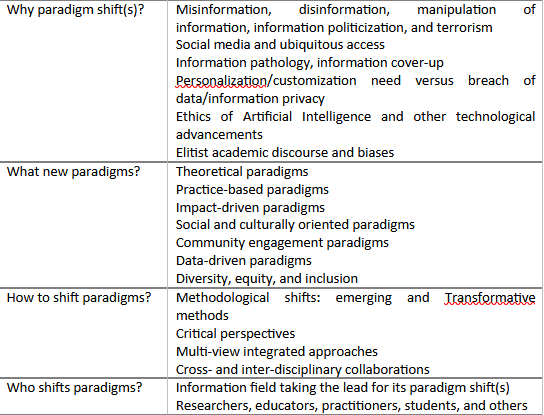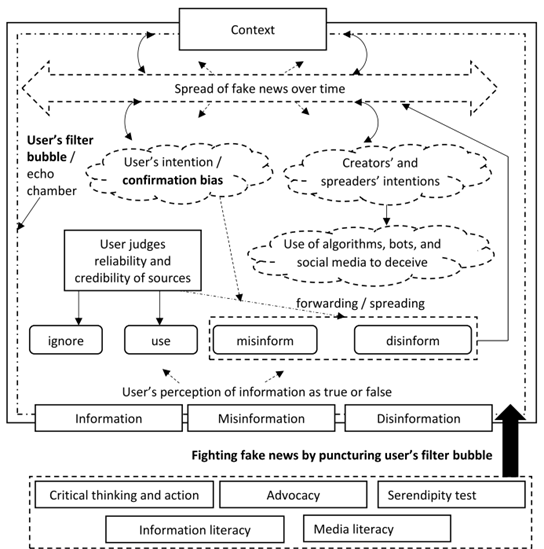Introduction
Information behavior describes the many ways in which human beings interact with information - how people seek and utilize information (Bates, 2017), but also includes other activities intentional/active and unintentional/passive activities (Wilson, 1999) such as avoiding/stopping, distorting, encountering by chance, organizing, storing, creating, sharing, diffusing, and deciding to stop using information (Agarwal, 2022). “It includes face-to-face communication with others, as well as the passive reception of information as in, for example, watching TV advertisements, without any intention to act on the information given.” (Wilson, 2000 , p. 49). The term came into wide use in the 1990s to replace earlier terms such as “information seeking” (Bates, 2017) or as a shorthand for the longer “information needs, seeking, and use” or INSU (Courtright, 2007).
Prior studies have attempted to review the history of information seeking and information behavior research in the past 50-60 years (see for example, Case and Given, 2016; Bates, 2017). While there have been recent studies looking at different aspects of information behavior, there is a need to bring the key conclusions from these together in one place, summarizing the more recent developments in this field in the twenty-first centurySome of the recent studies are listed here. VanScoy et al. (2022) looked at theory usage in empirical research in the papers published in the Information Seeking in Context conference between 1996 and 2020. Agarwal & Islam (2020) carried out a bibliometric analysis of articles published in the Journal of the Association for Information Science and Technology during the last two decades. Islam and Agarwal (2022) did a similar bibliometric analysis of papers published in the Proceedings of the Annual Meeting of the Association for Information Science and Technology during the last twenty years. Agarwal (2022) looked at information seeking behavior models and integrated models developed after the year 2000 (but also included models before 2000). Greifeneder & Schlebbe (2022) proposed a general model of the information behavior field. Case and Given (2016) include information seeking behavior research from the first decade of the twenty-first century. Ford (2015), Wilson (2020), and Jean, Gorham, & Bonsignore (2021) focus on the understanding of information behavior. Agarwal (2018) includes a comprehensive listing of information behavior research, especially as it relates to the context of human information behavior. Tang et al. (2021a, 2021b) cover paradigm shifts in information behavior research. Bates (2022) summarizes the research focal points of information seeking metatheories.
This paper seeks to answer the question, “What is the trajectory of information behavior research in the 21st century? What are some of the future directions?” The unit of analysis is research articles published on information behavior between the years 2000 and 2023. These include papers published in Information Research, the Journal of the Association for Information Science and Technology (Agarwal and Islam, 2020), and those presented in Information Seeking in Context conferences and the Annual Meetings of the Association for Information Science and Technology (Islam and Agarwal, 2022), research on information behavior models (Agarwal, 2022; Greifeneder & Schlebbe, 2022), theories (VanScoy et al., 2022; Bates, 2022), and context (Agarwal, 2018), and other related research.
While not meant to be exhaustive, this paper should bring new and existing researchers up to speed on some of the recent developments in the field during the past two decades. The rest of the paper is organized as follows. The next section includes a literature review. This is followed by methodology, and then the main contribution of the paper - highlights of information behavior research from 2000-2023. This is followed by future trends and directions. The last section on discussion and conclusions also includes limitations and implications.
2. Literature Review
This section focuses on two major themes - information science and metatheoretical approaches in information behavior research.
Information Science
Information behavior is a stream of research within the wider field of information science. An understanding of information science helps us understand information behavior better. At the inaugural Information Science summit organized jointly by the Association for Information Science and Technology (ASIS&T), the Association for Library and Information Science Education (ALISE), iSchools, and the Special Libraries Association (SLA) on October 28, 2022 in Pittsburgh, Pennsylvania, a panel of iFederation Leaders (representing ASIS&T, ALISE, and iSchools), Deans, Directors, and Chairs discussed “What is information science?” (IS Summit, 2022)
Gary Marchionini, Dean, University of North Carolina, Chapel Hill described information as intellectual energy and information science as the study of the genesis, organization, flow, use, and preservation of intellectual energy and its impact on humanity. Michael Seadle, Professor, Berlin School of Library and Information Science described information science as a philosophy where we understand information as something as broad and integral as historians understand the relationship with the past. He said that what we study in information science are the relationships between this thing called information which has context as well as data. Vivek Singh, Associate Professor, Rutgers School of Communication and Information, defined information science as a study of the intersection between humans and information, especially in an age of abundance. Recalling the movie Forrest Gump, Abebe Rorissa, Director, University of Tennessee, Knoxville described information science as what information science does. Rong Tang, President, ALISE, said that information science has the component of scholarship and study, but added the professional practice component to it - the applied and practice context that information science is contextualized in. In the panel in his role as President of ASIS&T, the author described information science as a triangle with three ends - human (that Brenda Dervin described in phenomenological terms as a “body-mind-heart-spirit moving through time and space, with a past history, present reality, and future dreams or ambitions.”, Foreman-Wernet, 2003, p.7; Agarwal, 2012), information, and technology. Since most of the world is interacting with information often mediated by technology, he defined information science as the “entire world”. Sanda Erdelez, Chair, iSchools and Interim Dean, College of Organizational, Computational, and Information Sciences, Simmons University described information science as a systematic study of information and systems in which reside information, people that interact with the information, and the social contexts in which these people exist - an ever-evolving field with a target that we don't know where it is. (Agarwal, 2022b)
Metatheoretical approaches in information behavior research
Agarwal (2022) reviews the major metatheories used in human information behavior research. He concludes that cognitive and social approaches are the two basic streams in the conceptual development of information seeking (and other forms of information behavior) focusing on the central role of the user, though there are others, such as affective approaches (e.g., see Nahl and Bilal, 2007; Savolainen, 2014) that study the role of emotion in information seeking and system-centered approaches. Cognitive approaches, which cover conscious intellectual activity, focus on the interactions between the user and the system and are concerned with user attributes and knowledge structures (Belkin, 1990; Agarwal, 2022). Social approaches focus on the user’s social context and include collaboration or collaborative information seeking (Shah, 2012). Multifaceted approaches cover the cognitive, social, and organizational context (Pettigrew, Fidel, and Bruce, 2001; Ingwersen and Järvelin, 2005). Agarwal (2018) classifies the views of context as personal view (combining cognitive and affective approaches), shared view (social approach), and stereotyped view (primarily cognitive). Agarwal (2014) discusses the idea of embodiment where a child interacting with a smartphone or tablet is part of a context that is embodied within a larger physical context of a room or a backyard. Agarwal (2018)discusses how embodiment enables portability where a person talking on the phone can walk out of the airport with a continuity of engagement with the person one is speaking with on the phone but having a change in physical surroundings. A preliminary understanding of these helps us view the developments in information behavior research in the twenty-first century as combining one or more of these metatheoretical approaches.
In the 2020 ASIS&T SIG USE Symposium, Jenna Hartel made a presentation on the major turns in the Information Science field based on her paper “Turn turn turn” (Hartel, 2019) - the cognitive turn, the affective turn, the neo-documentary turn, the socio-cognitive turn, the everyday life turn, the social constructionist turn, and the embodied turn (Agarwal & Franco, 2021). The following is a summary of seven turns in LIS by Hartel (2019). The cognitive turn in the 1980s featured a turn from the system-centered era to a user-system approach, with the user and their thought world becoming the foremost object of inquiry. In the affective turn of the 1990s, the user or the actor's emotional experience became a matter of keen interest. The neo-documentary turn of the 1990s focused on the properties and types of documents, their social and cultural construction within many different contexts, their changing nature in the digital age, and applied problems of documentation like retrieval, annotation, preservation, authorship, identity, intellectual property, etc. Another turn of the 1990s, the socio-cognitive turn, shifted attention from individual and internal knowledge structures to the outward and social construction of knowledge within communities in social, organizational, and professional contexts. Researchers in the everyday life turn sought to understand and celebrate information phenomena associated with routine or pleasurable and profound life experiences. In the early 2000s, proponents of the social constructionist turn argued that library and information science should define its subject matter as conversations, not information. The embodied turn in the mid-2000s focuses on the role of the body as the subject of research in the field and shows the natural logical step in the progression from the mind, heart, and body within LIS, aiming for a holistic understanding of the human information experience (Hartel, 2019).
Bates (2022) models information in relation to human beings in six frameworks-the self, the thinking, motivated being, within the body, existing in a physical ecology that is shaped by society - all the social and cultural elements of human existence, discourse, and documentation, and places sixteen methodological and theoretical metatheories in relation to these frameworks. See Figure 1. Bates describes it as a simplified diagram of the various principal domains where various theoretical and methodological approaches have concentrated their attention on considering the role of information in human life. Bates says that the display is approximate, with information being the unique core of our field, that could be studied from many directions and perspectives. Using any one of the metatheories, a researcher will be able to trace the role or impact of information in human life and institutions from the perspective of that metatheory (Bates, 2022).
3. Methodology
This study primarily adopts a literature review method for gathering evidence. While the study can be seen as a long and detailed literature review, it would be useful to classify it as belonging to a particular type of literature review. Grant and Booth (2009) present a typology of 14 types of reviews of the literature, including their associated methodologies, key characteristics, and perceived strengths and weaknesses. Based on their typology, the review method utilized in this study can be seen as an umbrella review. Such a method refers to a review compiling evidence from multiple reviews into one accessible and usable document. It focuses on a broad condition or problem for which there are competing interventions and highlights reviews that address these interventions and their results. There is the potential for greater use of such overarching reviews as a mechanism for aggregating findings from several systematic reviews that address specific questions (Grant and Booth, 2009). While umbrella reviews typically identify component reviews but do not include searches for primary empirical studies, this paper utilizes primary studies as well in some cases.
The sources utilized in this paper for an umbrella review include the following primarily (that are listed in parentheses; some of the acronyms used in this section are explained in the rest of the paper):
-unified models of information behavior (Agarwal 2022; Greifeneder & Schlebbe, 2022)
-context in Information behavior (Agarwal, 2018)
-analysis of JASIST proceedings (Agarwal & Islam, 2020) and ASIS&T conference proceedings (Islam & Agarwal, 2022)
-theory usage in empirical research in ISIC conference papers (VanScoy et al., 2022)
-metatheoretical approaches (Agarwal, 2022; Bates, 2022)
-definitions for information science (panel at 2022 Information Science Summit - Agarwal, 2022b)
-impact (Wilson, 2020)
-future trends (Tang et al., 2021a, 2021b, ARIST call for submissions, and other sources)
Apart from reviews, specific primary sources were utilized, as appropriate. Content analysis (see Krippendorff, 2018) was a suitable method for the following portions as it helped in creating word clouds summarizing the major topics researched in information behavior since the year 2000. Along with an umbrella review, the study utilizes the content analysis method for:
-analyzing titles of papers published in the journal, Information Research. This involved creating and populating a spreadsheet compiling the paper titles and links to papers for each paper published in each number and volume of the journal from 2000 to 2023.
-identifying future directions. This involved analyzing titles of posters and papers published in ASIS&T 2022, ISIC 2022, and CoLIS 2022 conferences.
Information Research (which includes proceedings of ISIC and CoLIS conferences) is used as a major source for this paper as it is a top journal dedicated to information behavior research, which is the subject of this paper. JASIST is a top journal in information science and technology, and the ASIS&T annual meeting is a primary conference organized by ASIS&T that brings together researchers in this field.
A lot of the author’s work (e.g., Agarwal, 2018, 2022) has been about synthesizing the contradictions in our field. Thus, you find these listed above. When writing this article, he debated over referring to his works in the first or the third person. To maintain consistency with the rest of the references, he has chosen the third person when citing himself in the paper.
4. Information behavior research in the twenty-first century
To highlight the key threads in information behavior research from 2000-2023, this section focuses on these areas: unified models of information behavior, context in information behavior, analysis of titles of papers published in Information Research, analysis of JASIST and ASIS&T proceedings, and theory usage in empirical research in ISIC conference papers.
Unified models of information behavior
Agarwal (2022) proposed a unified model of information seeking behavior that he arrived at by mapping various common elements of information seeking in the past few decades.
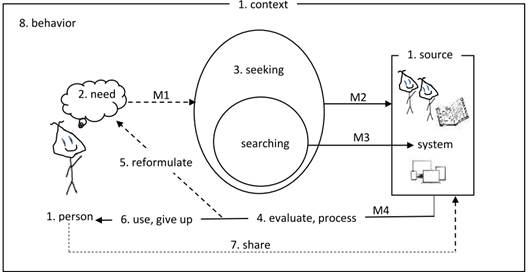
Source: Agarwal, 2022
Figure 2 A unified model of information seeking behavior Arrows indicate sequence. Dotted arrows indicate actions which may or may not occur. Numbers identify elements. Person, source and context have the same number, as person and source are part of context. M1, M2, M3 and M4 are moredating variables
The model shows a person or a user (labeled 1 in the figure) who engages in a seeking (3) or searching task from various information sources (1) when confronted with a need (2) for information that arises in a certain work or everyday life context (1). The person evaluates and processes (4) the information received and reformulates (5) the query to help answer more questions that arise. At some point, the person may decide to give up (6) searching for more information, and use (6) or share (7) the information that is retrieved. The various steps in this information behavior may be affected by a series of moderators labeled M1, M2, M3, and M4 in Figure 2.
Agarwal (2022) compared the common elements in different models of information seeking/behavior from the year 2000 onwards (also before that) and arrived at a table that included these various elements of Figure 2. Tables 1a and 1b below show these common elements mapped to nine models that Agarwal chose to compare in his paper. The first few rows in the table map to the context variables of environment, role, task, situation, person, source, and system, which all affect the information seeking behavior. These are followed by the terms used in the models that relate to information need, seeking/searching, evaluating/processing, use, and sharing of information. He then lists the specific type of information behavior exhibited in the models. Finally, he classifies each model based on the metatheoretical approach used in it, whether cognitive, social, affective or a combination of these.
Agarwal extends his unified model of information seeking behavior to include other forms of information behavior, other than seeking and searching. These other behaviors include information avoidance, stopping (Agarwal & Lu, 2020; Agarwal, Mitiku, & Lu, 2022), distortion (Agarwal & Alsaeedi, 2021), serendipitous information encountering (see Agarwal, 2015; Agarwal, Huang, & Erdelez, 2021), information organization, storing, disuse, information creation, information diffusion (Agarwal & Alsaeedi, 2021), as well as the user collaborating (Shah, 2012; Agarwal & Rahim, 2019) with another person on a task or project. See Figure 3.
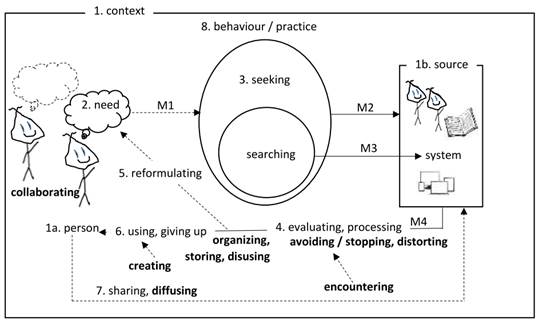
Figure 3: A unified model of information behavior Bold indicates other information behaviors. Arrows indicate sequence. Dotted arrows indicate actions which may or may not occur. Numbers identify elements.Person, source and context have the same number, as person and source are part of context. M1, M2, M3 and M4 are moderating variables
Greifeneder & Schlebbe (2022) also propose a general model of the information behavior field combining information behavior, information experience, and information practice. They list the various ways in which humans interact with information (which they call information use) and how humans do not interact with information (which they call information non-use). They term information behavior as the totality of the (non-)interaction of humans with information. See Figure 4.
Context in information behavior
As seen in several definitions of information science (Agarwal, 2022b), information behavior doesn’t exist outside of context. Agarwal (2018, Chapter 2) includes a detailed literature review of the empirical studies in information behavior and how they have incorporated context. This includes the populations studied (various professions, roles, and different demographics), methods used (quantitative - surveys and experiments, qualitative - interviews/focus groups, ethnography/observation, content analysis, and mixed methods), a detailed analysis of variables studied, type of information behavior studied, and context categories or elements affecting information behavior.
Agarwal (2018, pp. 125-126) reached certain conclusions about context:
1-Context is of the person or actor engaged in a behavior or activity. This could be any information behavior, such as seeking, searching and retrieval, interaction with a person or a device, serendipitous encountering, collaborative behavior, sharing, use, avoiding, etc. Without the behavior or activity (which also includes rest and inactivity), context doesn’t have much meaning or use. The same person would have a different set of contexts at different points of conversation, behavior, and interaction. Context is always created at the point of interaction (Dourish, 2004).
2-Context is always about the relationship - of the actor with entities outside of the actor or even with themselves.
3-Context is not one “whole” concept, which will look the same from every direction. Depending on who you are, where you’re looking from, and who the actor in question is, context will appear differently to you. Agarwal (2018) defines three views of context-the actor’s personal view of context, the shared view of context, and a stereotyped view of context. The first two views may be most used by the interpretivist researcher. The positivist researcher and the system developer may be using the third, stereotyped view. From an analysis of empirical research conducted on information behavior (see Chapter 2 of Agarwal, 2018), we can conclude that a majority of the context studied in research is the stereotyped view of context.
As an example of one of the three views of context, Figure 5 shows the shared view of the contextual identity framework. It shows two actors with their own personal contexts of identities and familiar information sources, as well as a shared circle of context between them when they’re engaged in collaborative information behavior (CIB). There are also contexts which they both may not be familiar with - people or information sources which are stereotyped contexts from their points of view.
1) The elements of context of an actor engaged in an activity (information behavior/information interaction) include aspects of the environment, task/activity/problem situation, need/information required, actor, source/system/channel, actor/source relationship, and time/space. These elements are significant because they demarcate almost everything affecting information behavior that has been studied in the twenty-first century and before that. Figure 6 shows these seven elements shaped by the three views of context (Agarwal, 2018, p. 99). Table 2 (from Agarwal, 2018, pp. 105-107) lists these elements and examples of variables studied that fall within these respective context elements. Figure 7 shows context elements and variables from the point of view of a researcher studying the information behavior of a group of people (stereotyped view of context).
Table 2 (from Agarwal, 2018, pp. 105-107) lists these elements and examples of variables studied that fall within these respective context elements.
Figure 7 shows context elements and variables from the point of view of a researcher studying the information behavior of a group of people (stereotyped view of context).
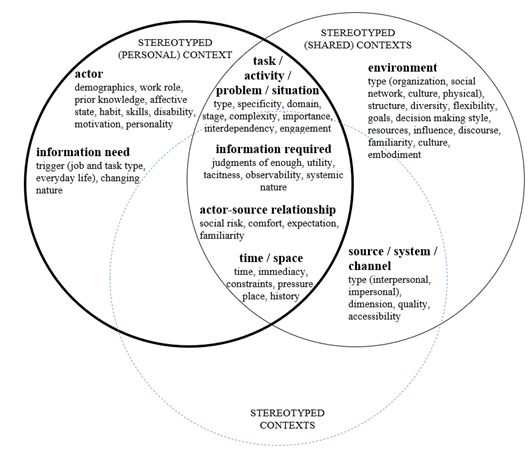
Figure 7: Context elements with variables when a researcher is studying the information behavior of a group of people (stereotyped view of context)
Based on his conclusions, Agarwal (2018) defines the context of an actor’s information behavior as consisting of “elements such as environment, task, actor-source relationship, time, etc. that are relevant to the behavior during the course of interaction and vary based on magnitude, dynamism, patterns and combinations, and that appear differently to the actor than to others, who make an in-group/out-group differentiation of these elements depending on their individual and shared identities.” (p.128)
Analysis of titles of papers published in Information Research since 2000
For this paper, we analyzed the titles of 1,314 papers published in Information Research between the years 2000 and 2022. With an average of 4 issues a year published in 22 volumes, 89 issues were published, including a Special Issue in 2023 which had the Proceedings of CoLIS (11th International Conference on Conceptions of Library and Information Science - Oslo Metropolitan University, May 29 - June 1, 2022) and the Proceedings of ISIC (the information behavior conference, Berlin, Germany, September 26-29, 2022).
A word cloud generating tool (https://wordart.com/create) was used to create a word cloud showing the most frequent terms mentioned in the titles of 1,314 papers published in Information Research between 2000 and 2022 (see Figure 8). We see that the words information, behavior, research, use, social, health, and seeking are among the most frequent terms used.
Table 3 shows a more detailed analysis of words and their relative sizes/frequencies found in the titles of all papers published in Information Research from 2000-2022. The words shown are in decreasing sizes with information being the most highly referenced word, followed by behavior, research, study, and seeking. From the 999 words generated by the tool (https://wordart.com/create), those with sizes 9 and above were included in the table to keep the table size manageable, while capturing the most frequently cited words in the paper titles.
Analysis of JASIST and ASIS&T proceedings since 2000
Agarwal and Islam (2020) analyzed the bibliographic information of full-length research articles published in the Journal of the Association for Information Science & Technology (JASIST) since the year 2000. Established in 1950, and with an impact factor of 3.275 (2021), JASIST is a premier journal in the Information Science field managed by the 85-year-old Association for Information Science & Technology (ASIS&T). Agarwal and Islam’s study included metrics such as article count, authorship, international collaboration, citations, and topical areas. Data was collected from SCOPUS, the JASIST website, and Scimago. Their findings show that JASIST published 3,052 articles during 2000 - 2020, which got cited 180,608 times (59.18 times per article) until 2020. Joint authorship has been increasing. Of the articles published during this period, 741 (24.27%) were single-authored, while three times more articles (2,311, 75.73%) were jointly authored. International collaboration has also been increasing. Figure 9 shows a graph based on the ratio of journal articles signed by researchers from more than one country for each year until 2018. Barring some years, the graph shows overall upward growth in international collaboration during 1999-2018.
Authors from institutions in 70 countries have published, with most articles from the US, with authorship from China steadily increasing in recent years. See Table 4.
Table 4: Share of top 10 countries in authorship of JASIST articles.
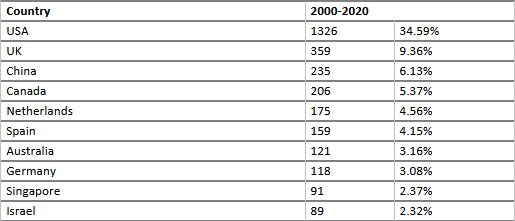
Source: based on Agarwal & Islam, 2020
Figure 10 shows the word clouds based on the titles of the 3,052 articles published by JASIST between 2000 and 2020 that Agarwal & Islam (2020) analyzed. The figure shows the word clouds based on article titles for five-year periods, and how these changed over time. For example, in 2000-2004, technology, web, retrieval, and search are among the top words used in the title of JASIST research articles.
Following up on Agarwal & Islam (2020), Islam & Agarwal (2022) analyzed the articles published in the conference proceedings of the Annual Meetings of the Association for Information Science and Technology from 2000 - 2020. Their bibliometric analysis used three data sources (Scopus, ASIS&T proceedings website, and Scimago journal ranking) and a scientific mapping analysis using VOSViewer. The study found 3,129 publications in 21 volumes from 2000-2020, with the number of publications showing a mostly upward trend over time (48 publications in 2000 and 217 publications in 2020; 347 publications in 2000-2004 and 877 publications in 2015-2019). Of all the publications during these 21 years, more than three-quarters (77.57%) were jointly authored. Figure 11 shows the percentage of publications each year that have co-authors from different countries. The graph shows that international collaborations were highest in 2016 with more than a quarter of collaborative publications, with a decline in 2017 and a pickup in 2018 above the high 2006 levels (Islam & Agarwal, 2022).
Islam & Agarwal found that 2,726 articles have been cited 9,705 times in 19 years (they excluded 2005 and 2020 in their analysis based on data available), with an average of 3.6 citations per article. Most authors are from U.S., Canada, and China. Table 5 shows the top 20 author-institution countries (with their ranking in the first column, and the number of publications in the second column).
Table 5: Top twenty author-institution countries (2000-2019, excluding 2005) 
Source: based on Islam & Agarwal, 2022
To investigate major research topics studied, Islam & Agarwal (2022) wanted to see the frequency of all keywords in the ASIS&T proceedings and their co-occurrences (or appearing together) with other keywords. They analyzed the 4,384 keywords that appeared in the proceedings from 2000-2019, excluding 2005. These are visualized in the map of Figure 12. ‘Social media’ was the most frequent keyword, appearing 103 times, followed by ‘information behavior’ (97) and ‘scholarly communication’ (50). 'Information behavior' here doesn't include the more qualified keywords like ‘information seeking behavior’, 'mobile information behavior', or 'health information behavior' (Islam & Agarwal, 2022).
Figure 13 shows the co-citations of cited sources in the ASIS&T proceedings (Islam & Agarwal, 2022). The Journal of the Association for Information Science & Technology (JASIST) and Information Processing and Management are the sources most cited in the publications of the ASIS&T Annual Meeting proceedings.
Theory usage in empirical research in ISIC conference papers (2000 - 2020)
VanScoy et al. (2022) analyzed the ISIC conference proceedings from 1996 to 2020 to identify 243 papers that reported empirical research. They used content analysis to determine theory usage (if at all, unsubstantial, or substantial) in the paper and the discipline from which the theory originated (including information science).
Of the 203 empirical research papers in the 11 biennial ISIC conferences from 2000-2020, 156 used theory. Thus, theory usage is in 76.85% or about three-quarters of all papers in the proceedings. Of the papers that used theory to some extent, VanScoy et al. found 69% (1996-2020) to have used theory substantially. They found the papers to have used 229 unique theories, with as many as 53 unique theories used in a single year’s papers in 2012. Between 1996 and 2020, they found 545 instances of theory use, with fewer theories used substantially (203 or 37%) than insubstantially (342 or 63%). Of these 543 instances of theory use in ISIC empirical papers, a vast majority (352 or 64.82%) are from information science while the rest are from other fields - sociology (69 or 12.7%), psychology (44 or 8.1%), communication (33 or 6.08%), business/management (20 or 3.68%), education (10 or 1.84%), and other disciplines (16 or 2.95%).
Table 6: Models/theories used at least thrice in ISIC empirical papers from 1996-2020 (VanScoy et al., 2022)
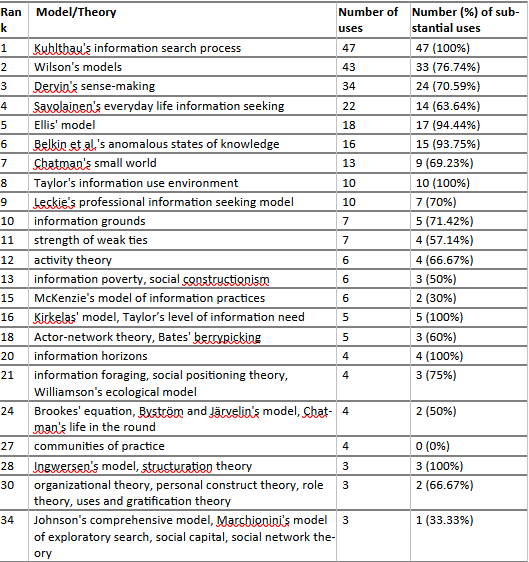
Table 6 (adapted from VanScoy et al., 2022) shows the models/theories used in information behavior research ranked from the most popular onwards. For each model/theory, VanScoy et el. list the number of uses in the ISIC conference papers, along with information on how many times such usage was substantial. The top 3 models/theories (those of Kuhlthau, Wilson, and Dervin) were used in all 13 conferences since 1996. These, as well as Ellis’ model, showed peak usage in early conference years, while Savolainen’s model is trending towards more use in recent conferences than in earlier years (VanScoy et al., 2022).
Fisher et al. (2005) and Wilson (2020) serve as other useful sources for theories in information behavior research. Wilson (2020) also considered the impact of information behavior research on other fields and found that fields such as computer science, health sciences, information systems, and education have largely imported ideas from information behavior research (76-91%) while exporting some of their ideas to the field (9-24%). A JASIST special issue on information behavior and information practices theory (Willson, Julien, & Burnett, 2022) focused on recent theory development and usage in the information field, continuing the work of Fisher et al. (2005).
Future trends and directions
Analyzing recent conference papers, and especially posters, provides a good snapshot of the types of areas that researchers are focusing on in the fields of information science and information behavior. They provide trends for the immediate future.
The word clouds of Figure 14 (generated using (https://wordart.com/create), show the top keywords studied as reflected in a) the virtual and in-person posters presented at the 85th Annual Meeting of the Association for Information Science & Technology (ASIS&T 2022); b) the long and short papers presented at ASIS&T 2022; c) the papers presented at ISIC 2022: the information behavior conference; and d) the papers presented at CoLIS 2022: 11th International Conference on Conceptions of Library and Information Science. It is interesting to note that data and Covid are emerging as important keywords of interest in current studies.
Table 7 shows these top keywords in more detail (generated by wordart.com). The table also lists the subject areas classifying the papers as listed in the conference program or proceedings. These subject areas provide more information on the content of the papers as classified by the conference organizers.
Tang et al. (2021a) discuss paradigm shifts in the field of information. They provide the reasoning and motives (why) for shifting paradigm(s) and specified what new paradigm(s) might be adopted (what) by specific community stakeholders in the information field (who), and the strategies and approaches we might employ to actualize these shifts (how). See Table 8. The ‘what’ part (second row) of the table states that new paradigms might be theoretical, practice-based, impact-driven, social and cultural-oriented, data-driven, or based on community engagement or diversity, equity, and inclusion (DEI).
The JASIST special issue on paradigm shifts provides examples of a range of new paradigms including critical perspectives, socio-emotional paradigms, methodological paradigms, and technological paradigms (Tang et al., 2021b). Examples of critical perspectives in the special issues include fully acknowledging the work of underrepresented or marginalized LIS scholars in existing paradigms (Cooke & Kitzie, 2021), focusing on people as knowers, speakers, listeners, and informants rather than ‘users’ for new understandings of information behavior and information literacy (Oliphant, 2021), and epistemicide or killing/devaluating of a knowledge system happening within our field and the ways we have systematically undermined knowledge systems falling outside of Western traditions (Patin et al., 2021).
A December 2022 call for submissions for the Annual Review of Information Science and Technology (ARIST) which publishes comprehensive and systematic reviews on topics relevant to information science listed new and emerging research topics of potential interest such as the rise of “big data” and machine learning; social media platforms and social change (e.g., #metoo; #blacklivesmatter); misinformation and disinformation; implications of COVID-19 on health information seeking; and youth engagement with social media platforms (e.g., Tik Tok).
Misinformation, disinformation, and fake news is certainly a topic of current and continuing interest with the coining of the term ‘infodemic’ where technological and social media advancements have led to ease of automation of false narratives. Agarwal & Alsaeedi (2021) propose a model of misinformation behavior, while Wilson (2020) calls the phenomenon information misbehavior (pp. 15-16, 30-31).
Figure 15 shows Agarwal & Alsaeedi (2021)’s disinformation behavior framework on the fake news phenomenon and ways to fight it. Misinformation is false information while disinformation is intentially false information. When applied to news, the phenomenon is termed fake news. As per the framework, all false information arises within a certain context such as national elections, COVID-19 pandemic, etc., where, depending upon the intentions of creators and spreaders of false information, algorithms, bots, and social media can be used to deceive. Fake news spreads over time, aided by those who create and spread it, with the intention of influencing outcomes or changing historical narratives. The person or user, as a consumer of information, and depending on their judgement of the credibility and reliability of information and sources (where such judgment is, in turn, affected by one’s confirmation biases and propensity to believe in false narratives) might decide to use, ignore, forward or spread this (mis/dis)information. All this happens within a filter bubble or an echo chamber that the user resides in, where their sources of information such as social media contacts or news media they consume, might further reinforce the user’s biases. The framework proposes ways to fight false information through advococy, critical thinking and action, information/media literacy, and tests for serendipity to determine if the information encountered is truly serendipitous or planted for the user to consume. These methods would help in puncturing the user’s filter bubble.
The phenomenon described above can be further informed by different perspectives. First, Agarwal & Alsaeedi (2021)’s framework does not address the cost or price of puncturing filter bubbles. While a number of studies have cited the difficulty in fighting false information (comparable to fighting rain by holding an umbrella and hoping not to get wet), they have not always looked at what happens when one is relatively successful in puncturing filter bubbles. A December 26, 1962 cartoon by R.K. Laxman which reads, “Of course you weren’t spreading rumours - the charge is you were spreading facts!”, points to the dangers faced by individuals in different countries and societies who risk being targeted for speaking truth to power and challenging false narratives. Second, while most studies in information behavior in the past two decades have looked at the user as the seeker of information and information sources as ‘giving’ or ‘informing’, studies can also look at the user as one not just consuming but forwarding, spreading, and disseminating false information, either because one is unaware, or with an aim to ‘misinform’ or ‘disinform’. Thus, it can be argued that there is a paradigm shift in the way in which those who 'use' information are influenced by the interests of those creating and spreading false information. Future research can study the disinformation and fake news phenomenon from these perspectives as well.
Contemporary research and writing have frequently focused on how smartphones disconnect us from our physical environment and the people present in the room (e.g., Turkle, 2011; Powers, 2011). This follows from research on information overload and the recommendations to unplug from technology. Yet, there is a digital disconnect happening as well - almost daily, people choose not to respond to certain messages or calls, which can make the sender anxious, and adversely affect their communication. Recent research has looked at the receiver’s reasons for not responding (Agarwal, Mitiku, & Lu, 2022), and the psychological impact on the sender (Agarwal & Lu, 2020) and on the other communication that they have with themselves and with other people. Research in information behavior has not typically looked at this area of non-response behavior, information avoidance behavior, and information-stopping behavior, which impact the social media communication and mental health of a large number of people using smartphones. More research is needed in this area.
The quick transfer of information enabled by the internet and social media has also led to an accelerated ability to transfer hate. E.g., the aftermath of a court verdict in January 2023 led to mobilization and the intense othering of a particular community in the state of Sikkim in India. An emotive piece seeking to heal divides (Agarwal, 2023a) was largely received positively by members of various communities, but also met with rejection in social media comments in some places (e.g., the Facebook comments under Agarwal, 2023b) that included a widely publicized rebuttal justifying exclusiveness as opposed to inclusiveness. This points to the continuing difficulties in diversity, equity, inclusion, and accessibility (DEIA) work in parts of the world. The opportunities and challenges for DEIA and the role of social media should be research topics of continuing interest.
A lot of research in 2020 and 2021 focused on COVID and information behavior surrounding it. While many world events have taken place in the recent past, COVID has changed the world in fundamental ways, including most people either experiencing the loss of loved ones or knowing family or friends who would have experienced that loss. This has brought about a greater mainstream realization of the fragility of human life and how people are struggling in different ways. Another effect has been a more widespread comfort of doing things online, moving many people and workplaces towards a hybrid way of working. COVID is likely to be around in the future as well, though hopefully, in a more manageable form. Thus, one topic of continuing interest would be how the information behavior of people has changed after the 2020/2021 COVID experience.
There have been studies on information behavior related to climate change, related immigration/migration (Balsari, Dresser, & Leaning, 2020), and climate change skepticism and debate (Foderaro & Lorentzen, 2023). These areas will remain important for future research.
Other topics of interest would be health and fitness, big data, artificial intelligence, and ChatGPT, serendipity versus productivity (see Sunoo, Erdelez, & Agarwal, 2023 who discuss how productivity apps can also be used to facilitate information encountering and serendipity, which help creativity and innovation), mental health and happiness, people’s information worlds with pets and the embodied aspects of information in such relationships (Solhjoo, 2022), and the role of human-information-technology interactions in all these phenomena.
Discussion and Conclusions
This was an ambitious paper seeking to understand what has gone on within information behavior research since the advent of the twenty-first century, and what the future might look like. One way was to go through every single paper that has been published in this area in the past twenty-three years. This may not have been feasible in a timely fashion. Another way was to try and summarize the key findings from some of the major studies that have synthesized the research in this area during the past two decades. The task then was to bring them together in a way that is useful to a new researcher trying to understand this area or a seasoned researcher who would benefit from having key findings and arguments in one place. This paper followed the latter approach, while also doing a content analysis of the titles of publications in key journals and conferences of the field.
So, what did we learn? Let us try to summarize the key takeaways from the paper. We learned that the term information science is defined differently by different people who might have different definitions even for what information means. We also learned that there are various ways or perspectives (or metatheories) of looking at the phenomenon ranging from cognitive to social to affective to a mix of various approaches. Each of these perspectives provides a separate lens for trying to understand a phenomenon such as human information behavior.
We also see that many models have emerged in the information seeking and information behavior areas, as well as models that have tried to integrate these together. Agarwal (2022) has tried to unify these in a single model. At the heart of the each of these various models is the centrality of the person or the actor, who is often seen as a searcher of information, a person accessing different types of information, who might use information or give up - but increasingly this person is also seen as diverse, having intersectional identities, and is trying to make sense of the world and all the information that emanates from it. Some of this information can be relied upon, and a large portion of it may either be deliberately or inadvertently false or too much for a person’s mind to handle. This person also may not know what to make of life, especially post-pandemic, and is trying one’s best to sometimes survive and sometimes thrive. They live between physical and digital worlds, one increasingly with virtual and augmented realities, and one affected by artificial intelligence - which can be both a challenge and an opportunity. Such a person also needs to deal with one’s mind and spiritual dimensions that they may experience at times. The person needs to either join or grapple with the cries of “us versus them” or learn to see everyone as themselves - not because people are all similar, but because they are different, and this individual difference is what makes people similar to each other.
Along with the person and the information sources that the person goes to and the information world that they inhabit, a primary aspect of the information behavior field is context. Brenda Dervin called it an “unruly beast” (Agarwal, 2012, 2018). We understand that context is of a person engaged in an activity - thus, without a specific type of information behavior - whether seeking, searching, evaluating, processing, avoiding, stopping, distorting, organizing, storing, using, disusing, creating, sharing, or encountering information (Agarwal, 2022) in a specific time and place - whether physical or digital or multidimensional/augmented, context has no meaning. The context of this author writing this paper is very different from that of this author picking one’s child from school, buying groceries in the supermarket, or teaching a group of students. Context looks different when viewed from different perspectives and can be reliably seen as consisting of one of seven elements - actor, environment, task/activity/problem situation, need/information required, source/system/channel, actor-source relationship, and time/space (Agarwal, 2018), with most variables studied in information behavior in the twenty-first century being aspects of one or more of these elements.
In most information behavior research, information, not surprisingly, is the most commonly occurring keyword. Thus, seeing ourselves as belonging simply to the information field may not be off the mark. Almost all the other keywords are either activities associated with information such as behavior, research, study, seeking, use, analysis, etc., or domains such as social, library, health, web, and so on.
We also see that authors in our field like to collaborate, and increasingly internationally and that countries outside North America such as China are making their presence felt in the information science literature (Agarwal & Islam, 2020; Islam & Agarwal, 2022). There are also calls for fully acknowledging the works of underrepresented and marginalized LIS scholars (Cooke & Kitzie, 2021).
In papers published in venues dedicated to information behavior research such as the biennial Information Seeking in Context conferences, theory usage is as high as three-quarters of all papers in the proceedings (VanScoy et al., 2022). There is still a debate about whether we produce more models and not enough theory, how much we borrow from other disciplines (about 35% of the time; VanScoy et al., 2022), and whether we contribute enough to research in other disciplines or not. We seem to have impacted fields such as computer science, health sciences, information systems, and education in certain ways (Wilson, 2020).
esearch trends for the present and future point to the role of information in mobile behavior, big data, disinformation, mixed realities, and DEIA, ethics of artificial intelligence, climate change and migration, among other topics, with several new and existing paradigms ranging from theoretical to practice-based to impact-driven, to socially and culturally oriented to data-driven, and to community engagement based (Tang et al., 2021a).
This paper has several limitations. It has provided an umbrella review from the perspective of a single researcher. Several primary sources might have been missed in the process of writing this paper. Second, another researcher in the information behavior field might have a different take on what the field has accomplished in the past two decades. Thus, this paper should be seen as one way or one perspective of looking back at the field, and into the near future. Third, this study has adopted more of a chronological or historical perspective in reviewing the past two decades of research in information behavior. Future research could adopt a more critical perspective. Finally, the reviews consulted are much more detailed. Only the key findings from them are included here. The reader is advised to delve into those sources for a deeper understanding.
This paper should be useful to students and emerging researchers in helping them quickly come up to speed on some of the major developments in the field of information behavior in the past two decades. It could be a useful paper to complement some of the other sources that have looked at information science and information behavior research wholistically such as Case and Given (2016), Agarwal (2018, 2022), and Wilson (2020). Future research can try to address some of the limitations of this work and include publications or perspectives that might have been missed. Other methods of data gathering such as systematic reviews and metanalyses can also be carried out. As an overarching theme, what we can conclude from this paper is that information behavior research is going to remain increasingly relevant even as the human experience straddles multiple stresses and undergoes profound changes in an ever-dynamic world.














